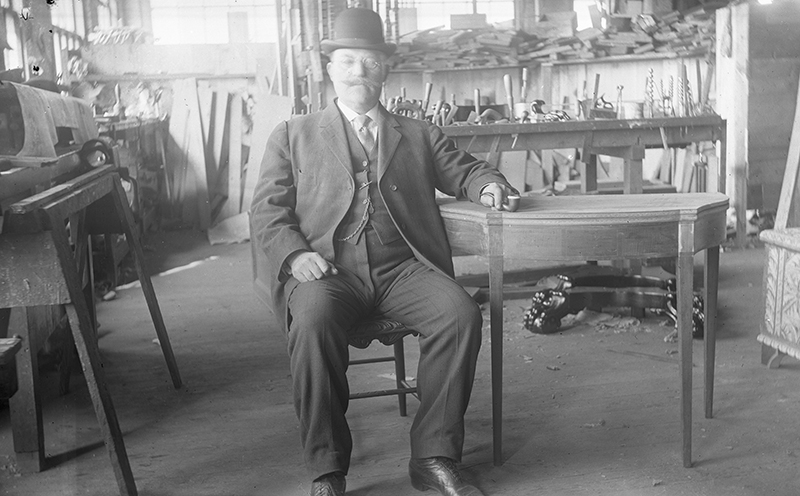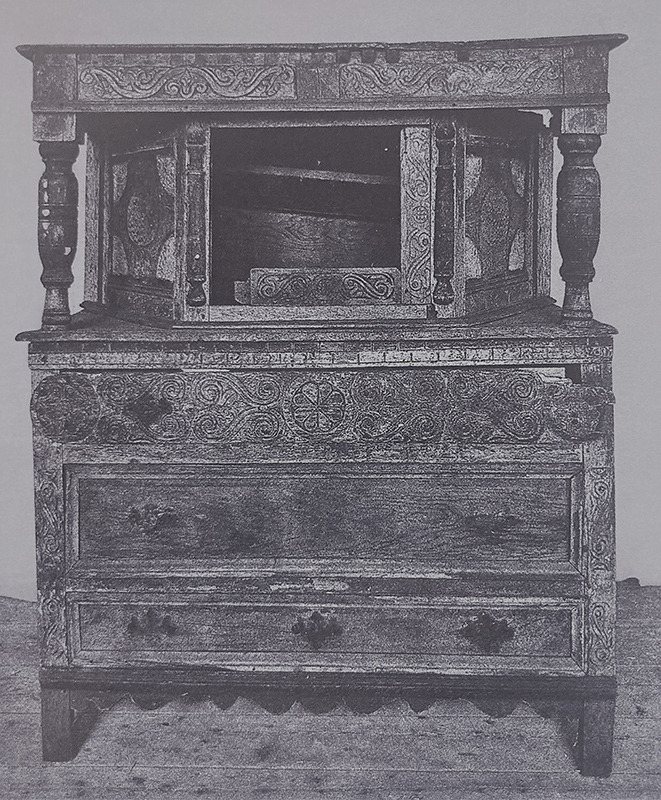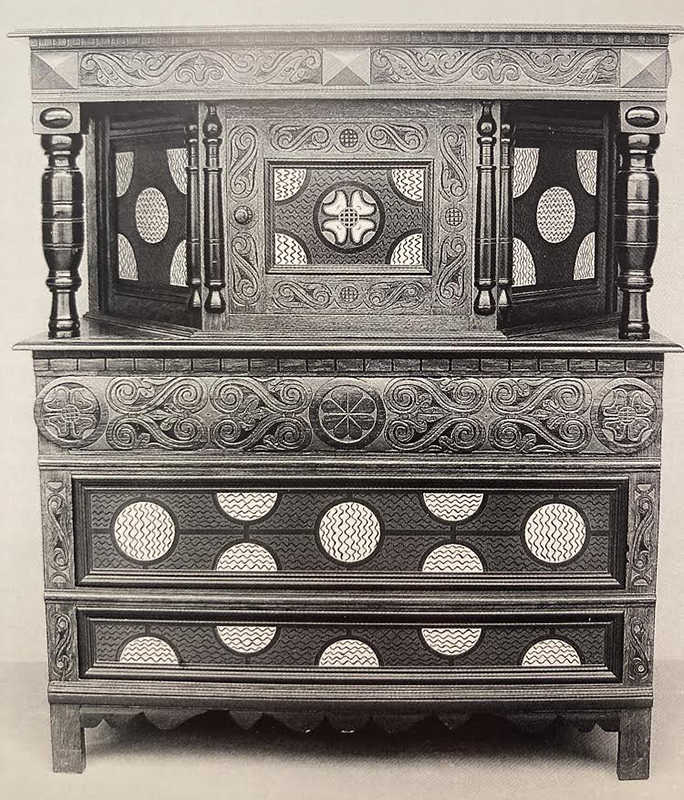Between Commerce and Craft: The Workshop of Olof Althin
by Trevor Brandt
An upcoming exhibition at the American Swedish Historical Museum in Philadelphia, PA, reunites the workshop and wares of Olof Althin (1859–1920), an immigrant cabinetmaker and antiques restorer in turn-of-the-20th-century Boston (figure 1). Throughout his life, Althin navigated the intersections between immigrant and American, reproducer and restorer, and designer and maker. Poised between these identities, Althin reveals the challenges of a cabinetmaker balancing economic enterprise with adherence to ideal-driven craft movements in the early-20th century American furniture trade.
Coming of age at the onset of Sweden’s industrialization, Althin witnessed staggering social and economic transformations as his hometown changed from an agricultural to an industrial economy. As a young man, Althin underwent traditional guild training at a furniture shop called Stenbergs Möbler in the nearby town of Sinrishamn. Yet even as Althin completed his apprenticeship, the ancient Swedish guilds were giving way to a system of deregulated regional handicraft associations. In this era of great transitions, Althin sought stability and fortune abroad.
Althin immigrated to Boston via Gothenburg in 1880, quickly finding work at the Evans & Toombs cabinetmaking firm. Althin was the first in his family to move to America, a decision likely motivated by economic opportunity. A strong furniture market attracted skilled immigrant labor to Boston from around Europe, including a proportionately large number of Swedish cabinetmakers, who competed with other foreign- and native-born craftsmen for work.
By 1886, Althin had enough capital to open “O. Althin Art Furniture & Interior Fittings” in Boston’s South End, which achieved renown for its sophisticated reproductions of colonial-era furniture (figure 2). Adapting to the demands of his wealthy clients, Althin’s reproduction furniture represents a range of pre-industrial American furniture styles. Althin’s better-known clients included Massachusetts State Senator George Crocker, industrialist Charles Sumner, and even John Wanamaker, who commissioned furniture for his home.
Yet Althin did not only reproduce American antique furniture. Beginning in the late-1880s, Althin began repairing and restoring antiques for collectors, most notably H. Eugene Bolles (1858–1910) and Charles Hitchcock Tyler (1863–1931). Cousins, law partners, and connoisseurs, Bolles and Tyler formed a decades-long partnership and friendship with Althin, who worked as their on-call antiques agent and restorer. Nearly every piece of furniture the collectors acquired before 1920 went through Althin’s shop for treatment, and many of these pieces later formed the core Americana collections of the Museum of Fine Arts, Boston and The Metropolitan Museum of Art, including a late-17th-century court cupboard (figures 3–5).
Employing a small staff of six to ten fellow Scandinavian immigrants, Althin balanced his firm’s successes with the expectations of international craft reform movements (figure 6). Late-19th century Boston was at the center of the American craft revival movement, which saw prominent designers, educators, and historic preservationists promoting a return to traditional craftsmanship in manufacturing. A similar movement had spread from Sweden to Boston in the late 19th century. Sloyd (slöjd, or handcraft) was a Swedish educational system of manual training grounded in woodworking, especially wood carving. Educator and immigrant Gustav Larsson (1861–1919) brought Sloyd to Boston from Gothenburg in 1888, founding the Sloyd Teacher Training School in 1890. Radiating from Boston, the school’s teachers brought Sloyd’s tenets of moral improvement through woodworking to hundreds of thousands of students throughout the country.1
Althin himself seems to have remained strategically distanced from both movements, neither joining Arts-and-Craft interest groups in Boston nor subscribing to Boston’s quarterly Sloyd Record publication. Althin’s small-scale shop did not deliberately emulate these movements’ ideals of handmade production nor the quaint notion of a lone master artisan executing an entire piece without the division of labor. Althin’s motivation was profit-based, and he mechanized elements of the furniture-making process where possible. Althin’s account books suggest that he frequently turned elements on the lathe, perhaps to market every product as having been worked on by the master craftsman. At its core, Althin’s small-scale shop was a cost-efficient operation familiar from his apprenticeship in Sweden.
While remaining aloof from contemporaries in the Arts and Crafts and Sloyd movements, Althin nonetheless wrote a remarkable manuscript in the first year of his retirement that situated an immigrant artisan’s knowledge within the American furniture trade. The unpublished Architect’s Designer’s and Draftsmen’s Guide for the Designing of Woodwork and Furniture, bridged the divide between academically trained designers and manually trained workers. In its introduction, Althin promised:
“I offer this book to fill the space as far as possible between theory and practice, in other words lead the draftsman with essential points of information along the lines in construction of woodwork as required by the nature of wood, known only to the one who has thoroughly learned the cabinet-maker’s trade.”2
Althin suggested that his primary qualification for bridging the gap between the theory and practice of cabinetmaking was his intimate knowledge of the physical nature of wood. In seeking to educate aspiring American designers about the practice of woodworking, Althin redirected the language of the Sloyd and Arts and Crafts movements from their emphasis upon production techniques towards materiality instead—the materiality of wood, or the single element common to businesses and design movements. In doing so, Althin carved his niche between the tenets of the Arts and Crafts movement, Sloyd, and the practical necessities of running a small cabinetmaking shop.
1 June E. Eyestone, “The Influence of Swedish Sloyd and Its Interpreters on American Art Education” in Studies in Art Education 34:1 (Autumn, 1992), pp. 28–38.
2 Olof Althin, Architect’s, Designer’s and Draftsmen’s Guide for the Designing of Woodwork and Furniture, handwritten manuscript (c. 1913). Collection 426, Box 1, Folder 2–4, The Joseph Downs Collection of Manuscripts and Printed Ephemera, Henry Francis du Pont Winterthur Museum.
Trevor Brandt is a PhD candidate and Neubauer Family Distinguished Doctoral Fellow in the Department of Art History at the University of Chicago. American by Craft: The Furniture of Olof Althin opens at the American Swedish Historical Museum on July 22. This exhibition was generously supported in part by a Failey Grant from the Decorative Arts Trust and was co-curated by Trevor Brandt and Erica Lome, PhD, Peggy N. Gerry Curatorial Associate at the Concord Museum.
A print version of this article was published in The Magazine of the Decorative Arts Trust, one of our most popular member benefits. Join today!






